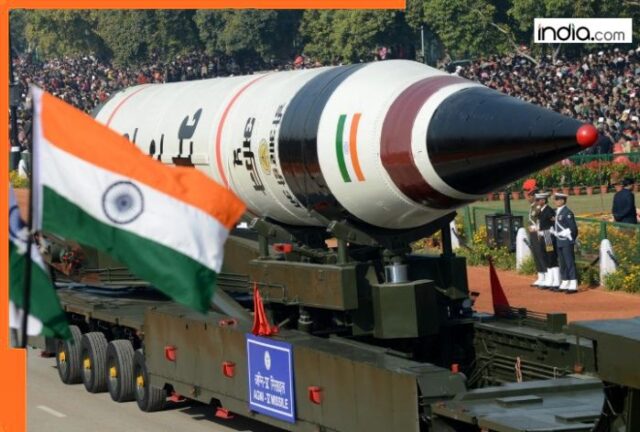The Agni-5 missile, dubbed by many as the the ‘Mahastra’ of India’s missile arsenal, is the country’s longest range ICBM with a with a payload capacity of around 50-56 tonnes, and the capability to carry a 1.5 tonne (1500 kg) nuclear or conventional warhead.
Agni-5 missile: India’s ‘Brahmastra’, the BrahMos missile, brought Pakistan to its knees during Operation Sindoor, as the homegrown medium-range cruise missile devastated Pakistani military infrastructure, including key airbases, while the enemy’s air defence system proved to be nothing more than a helpless spectator.
With its performance in the recent India-Pakistan clash, BrahMos has proven itself as a formidable weapon of war. But apart from BrahMos, there’s a much more lethal weapon in India’s arsenal which is feared by Pakistan and even China. The weapon we are talking about is the Agni-5 missile, a nuclear capable ICBM with an range of 5,000 km that can be extended to nearly 7,000 km if required.
Agin-5 – India’s ‘deadliest’ missile
Designed and developed by India’s Defence Research and Development Organisation (DRDO), the Agni-5 missile is a land-based nuclear MIRV-capable Intercontinental Ballistic Missile (ICBM) boasting a range of over 7,000 kilometers, which means that the missile can even strike deep inside the Chinese mainland.
The advanced ICBM is capable of flying at speeds of up to 29,400 km/hour, making it one of the fastest missiles in the world, and can strike virtually any target in Asia and beyond within a matter of minutes.
The Agni-5 missile, dubbed by many as the the ‘Mahastra’ of India’s missile arsenal, is the country’s longest range ICBM with a with a payload capacity of around 50-56 tonnes, and the capability to carry a 1.5 tonne (1500 kg) nuclear or conventional warhead.
Recently, the Agni V missile was equipped with Multiple Independently Targetable Reentry Vehicle (MIRV) technology under Mission Divyastra, giving it the capability to strike multiple targets simultaneously by carrying multiple warheads.
The Agni-5 ICBM employs multiple navigation systems, including GPS, NavIC, and the onboard micro navigation system to reach its target, and is powered by solid fuel, making it quicker to launch compared to liquid-fueled missiles.
Weighing 17 tonnes, and measuring 17 meters in length, the Agni-5 is always an imposing sight when its paraded through national capital Delhi during the annual Republic Day parade.
How Agni-5 gives India strategic edge in South Asia
But beyond its imposing presence, the Agni-5 missile provides a strategic edge to India in South Asia, particularly the Indian Subcontinent, as both Pakistan and China know that this lethal ICBM can strike deep within their countries in a war scenario.
Notably, Chinese experts believe India has deliberately understated the actual range of Agni-5 ICBM to prevent international oversight. They claim that the missile’s actual range could be more than 8,000 kilometers.
In contrast, Shaheen-3, Pakistan’s longest-range missile has a range of just 2,750 kilometers, and while China’s Dongfeng-41 missile may have a longer range, the recent integration of MIRV technology makes the Agni-5 missile a much more formidable option than any missile in Beijing’s arsenal.

















































